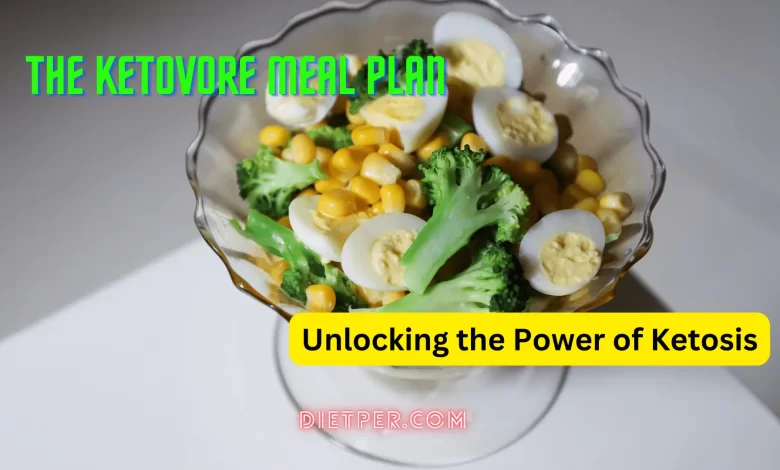The Ketovore Meal Plan 2023 – Unlocking the Power of Ketosis
The Ketovore Meal Plan: Unlocking the Power of Ketosis for Health and Well-being

The Ketovore meal plan: In recent years, the ketogenic diet has surged in popularity for its compelling benefits, spanning weight management to enhanced cognitive function. But what if there were a way to elevate the keto experience? Enter the Ketovore meal plan, an innovative approach that takes keto a step further by prioritizing unprocessed whole foods and eliminating plant-based items. The ultimate goal is to achieve Ketosis by embracing a diet rich in fats and proteins, mirroring the dietary habits of our ancestors.
Exploring The Ketovore Meal Plan
The Ketovore meal plan has garnered attention among individuals seeking effective avenues to meet their health and weight goals. This unique approach blends elements of the ketogenic diet and vegetarianism, emphasizing nutrient-dense animal-based foods while maximizing ketosis benefits.
Fundamentally, the ketovore eating plan encourages a substantial intake of healthy fats and proteins while drastically curtailing carbohydrates. This strategic carbohydrate reduction pushes the body into a state of Ketosis, where it becomes highly proficient at utilizing fat as the primary energy source rather than relying on glucose derived from carbs.
The Ketovore approach takes this concept a step further by heavily relying on animal-based sources for nutrition. This encompasses various types of meat like beef, poultry, and fish, alongside eggs, dairy products, and specific fats such as butter and lard. The exclusion of plant-based foods distinguishes the Ketovore strategy from other ketogenic diet variants.
Understanding Ketosis: How It Works
Ketosis is a metabolic state where the body transitions from using glucose as its primary energy source to relying on ketones, which are produced from stored fat. This state is achieved through the adoption of a low-carbohydrate, high-fat diet, commonly referred to as the ketogenic diet.
Here’s how it works:
Carbohydrate Depletion: When you consume a diet low in carbohydrates, your body’s glycogen stores gradually become depleted. This occurs because carbohydrates are the main source of glucose, which is used for energy.
Ketone Production: In response to carbohydrate scarcity, the liver begins breaking down fat cells. These fat cells are converted into ketones, which serve as an alternative energy source for the body. Notably, the brain readily utilizes these ketones for fuel.
Transition Period: The process of entering Ketosis varies from a few days to a few weeks, depending on individual metabolism and dietary adherence. During this transition, some individuals experience the “keto flu,” characterized by symptoms like fatigue, brain fog, and headaches.
Adaptation: As the body adapts to using ketones for fuel, these symptoms typically subside, giving way to increased energy and improved mental clarity.
In the state of Ketosis, your body becomes proficient at burning fat for energy, making it an effective approach for weight loss and body composition improvement. Beyond these benefits, Ketosis is associated with improved insulin sensitivity, reduced inflammation, and increased feelings of satiety.
To achieve and maintain Ketosis , it’s essential to restrict carbohydrate intake to approximately 20-50 grams per day while increasing fat consumption. This entails avoiding starchy and sugary foods and focusing on nutrient-dense sources of fats, such as avocados, coconut oil, and fatty cuts of meat.
Some Popular Meal Plan
- The Svelte Diet Plan 2023: Achieve Weight Loss Just 30 Days
- The Binghamton Meal Plan 2023 : What To Eat Or Avoid To Eat
- Exploring The SDSU Meal Plan For Fueling Success in 2023
- The Ketovore Diet: Exploring the Perfect Fusion of Keto and Carnivore
- 13 Famous Flavorful Delights Carnivore Diet Snacks in 2023
5 Benefits of the Keto vore Meal Plan
The Ketovore meal plan is a unique approach to the popular ketogenic diet, taking it to the next level by emphasizing animal-based foods and eliminating plant-based sources of carbohydrates. This specialized meal plan offers a variety of benefits that can transform your health and overall well-being.
Rapid and Sustained Weight Loss: Ketovore’s strict carbohydrate limitation forces the body into Ketosis, where it burns stored fat for energy. This leads to accelerated fat loss and reduced body weight.
Improved Mental Clarity and Focus: Eliminating processed carbs and sugars prevents energy crashes and brain fog. The brain benefits from a consistent supply of ketones derived from fat metabolism, enhancing cognitive function, concentration, and overall mental performance.
Stabilized Blood Sugar Levels: Ketovore eliminates quick carb-to-glucose conversion, preventing blood sugar spikes and crashes. This is particularly beneficial for those with insulin resistance, diabetes, or those seeking better blood sugar management.
Reduced Inflammation: The diet promotes nutrient-rich animal-based foods and minimizes inflammatory plant-based carbs, potentially reducing chronic inflammation. This can benefit overall health, including conditions like cardiovascular disease, arthritis, and autoimmune disorders.
Increased Energy and Athletic Performance: Shifting the body’s primary fuel source from carbs to fat allows athletes to access fat stores for enhanced endurance and stamina. The Ketovore plan also provides essential nutrients and electrolytes crucial for optimal physical performance.
Understanding the Macronutrient Ratios in the Keto vore Meal Plan
To fully grasp the effectiveness of the Ketovore Meal Plan and harness the power of Ketosis, it’s essential to comprehend the specific macronutrient ratios at its core. Unlike traditional diets that rely on calorie counting, the Ketovore Meal Plan emphasizes precise macronutrient ratios to initiate and sustain a state of Ketosis.
In the Ketovore Meal Plan, macronutrient ratios typically adhere to the following breakdown: approximately 70-75% of calories from healthy fats, 20-25% from high-quality proteins, and 5-10% from low-carbohydrate sources. This distinctive combination encourages the body to enter a metabolic state where it predominantly utilizes fat for energy rather than relying on glucose derived from carbohydrates.
The significance of the high-fat component in the Ketovore Meal Plan cannot be overstated. It serves as a consistent energy source while keeping insulin levels in check. This plan emphasizes healthy fats like avocados, nuts, seeds, olive oil, and coconut oil, not only for their essential nutrients but also for their ability to promote satiety and contentment.
Proteins also hold a pivotal role in the Ketovore Meal Plan by supporting muscle growth and repair. Quality sources of protein, including lean meats, fish, poultry, and plant-based options like tofu and tempeh, are prioritized. It’s essential to consume protein in moderation to prevent excessive intake, as excess protein can be converted into glucose and impede the ketosis process.
Lastly, carbohydrates are intentionally limited in the Ketovore Meal Plan to facilitate and maintain a state of Ketosis. By reducing carbohydrate intake, the body is compelled to rely on fat as its primary fuel source. However, it’s crucial to select low-carbohydrate options such as leafy greens, non-starchy vegetables, and low-sugar fruits to uphold the desired macronutrient balance.
Sample Ketovore Meal Plan and Recipes for Day
Incorporating the Ketovore meal plan into your lifestyle can be an exciting and transformative journey toward optimal health and vitality. To help you get started, we have put together a sample meal plan along with some irresistible recipes that will not only keep you in Ketosis but also satisfy your taste buds.
Breakfast
Kickstart your day with a hearty and delicious Ketovore breakfast. Try our Spinach and Mushroom Omelette, packed with protein and healthy fats. This recipe combines fluffy eggs with sautéed spinach, mushrooms, and a sprinkle of cheese for a flavorful and nutritious start to your day.
Lunch
For a satisfying midday meal, whip up our Avocado Chicken Salad. This refreshing salad boasts tender grilled chicken, creamy avocado slices, crisp lettuce, and a tangy vinaigrette dressing. Packed with healthy fats and lean protein, it will keep you energized throughout the day.
Snack
When those afternoon cravings hit, reach for a tasty and keto-friendly snack. Our Almond Butter Fat Bombs are the perfect bite-sized treats to keep you satiated. Made with almond butter, coconut oil, and a hint of vanilla, these fat bombs are a delicious way to curb hunger while staying in Ketosis.
Dinner
Indulge in a flavorful and satisfying dinner with our Grilled Salmon with Lemon Butter Sauce. This mouthwatering dish features succulent salmon fillets seasoned with aromatic herbs and spices and then grilled to perfection. Drizzled with a tangy lemon butter sauce, it is a true delight for your taste buds and a great source of healthy omega-3 fatty acids.
Dessert
End your day on a sweet note with our Keto Chocolate Mousse. Made with rich dark chocolate, creamy coconut milk, and a touch of stevia, this decadent dessert is a guilt-free indulgence that will satisfy your sweet cravings while keeping you firmly in Ketosis.
Remember, this sample meal plan is just a starting point. Feel free to customize it based on your preferences and dietary needs. Experiment with different flavors, ingredients, and cooking techniques to keep your Ketovore journey exciting and enjoyable.
Example of ketovore meal plan week
Planning your meals is essential when following a ketovore diet. This week, we have put together a comprehensive ketovore meal plan to help you stay on track and achieve your health and wellness goals. Our ketovore meal plan ensures that you consume adequate amounts of healthy fats, moderate protein, and minimal carbohydrates. By following this plan, you can optimize your body’s ability to burn fat for fuel and maintain a state of ketosis.
Day- 1 Monday
- Breakfast: Scrambled eggs with avocado and bacon
- Lunch: Grilled chicken salad with mixed greens, olives, and olive oil dressing
- Dinner: Baked salmon with roasted vegetables
- Snack: Celery sticks with almond butter
Day- 2 Tuesday
- Breakfast: Ketovore smoothie with coconut milk, spinach, and almond butter
- Lunch: Ground beef lettuce wraps with avocado and salsa
- Dinner: Grilled steak with cauliflower mash
- Snack: Hard-boiled eggs
Day- 3 Wednesday
- Breakfast: Ketovore omelette with mushrooms, bell peppers, and cheese
- Lunch: Tuna salad with mixed greens and olive oil dressing
- Dinner: Roasted chicken thighs with broccoli
- Snack: Pork rinds
Day- 4 Thursday
- Breakfast: Ketovore pancakes with sugar-free pancake syrup
- Lunch: Zucchini noodles with pesto and grilled shrimp
- Dinner: Baked cod with asparagus
- Snack: Cheese cubes
Day- 5 Friday
- Breakfast: Ketovore smoothie with almond milk, kale, and protein powder
- Lunch: Chicken Caesar salad with homemade dressing
- Dinner: Beef stir-fry with cauliflower rice
- Snack: Almonds
Day- 6 Saturday
- Breakfast: Ketovore frittata with spinach, bacon, and cheese
- Lunch: Egg salad lettuce wraps with sliced avocado
- Dinner: Grilled pork chops with roasted Brussels sprouts
- Snack: Sugar-free jerky
Day- 7 Sunday
- Breakfast: Ketovore muffins with coconut flour and blueberries
- Lunch: Shrimp and avocado salad with lemon vinaigrette
- Dinner: Baked chicken thighs with green beans
- Snack: Cucumber slices with cream cheese
Tips for a successful transition into the Ketovore Meal Plan
Embarking on the Ketovore Meal Plan can be a transformative journey toward better health and well-being. As with any dietary shift, a thoughtful approach and adequate preparation are key. Here are some essential tips to ensure a successful transition into this powerful lifestyle:
Educate Yourself
Before diving into the Ketovore Meal Plan, take the time to grasp its principles and guidelines fully. Familiarize yourself with the approved foods, macronutrient ratios, and the science behind Ketosis. This knowledge empowers you to make informed choices and extract the maximum benefits from this dietary approach.
Gradual Transition
Transitioning from a conventional diet to the Ketovore Meal Plan can be a significant change for your body. Instead of abruptly embracing extreme Ketosis, consider gradually reducing your carbohydrate intake over time. This gradual shift allows your body to adapt and reduces the likelihood of experiencing side effects such as the keto flu.
Meal Planning and Preparation
Effective meal planning is critical for success on the Ketovore Meal Plan. Stock your kitchen with keto-friendly ingredients like grass-fed meats, wild-caught fish, organic vegetables, and healthy fats. Invest in quality meal prep containers to simplify adherence to your meal plan, even on busy days.
Stay Hydrated
Adequate water intake is crucial while following the Ketovore Meal Plan. As your body enters Ketosis, it flushes out excess water, potentially leading to dehydration if not replenished. Aim for at least eight glasses of water per day, and consider incorporating electrolytes to maintain proper hydration.
Embrace Healthy Fats
Healthy fats are the cornerstone of the Ketovore Meal Plan. Integrate sources like avocados, coconut oil, grass-fed butter, and olive oil into your meals. These fats not only enhance satiety but also promote Ketosis while delivering essential nutrients for overall well-being.
Listen to Your Body
Each individual’s response to the Ketovore Meal Plan may vary. Pay close attention to how your body reacts and adjust your macronutrient ratios or food choices accordingly. Some individuals may thrive with higher fat intake, while others may benefit from more protein. Trust the signals your body sends and adapt as needed to achieve optimal results.
By following these tips, you’ll embark on a successful transition into the Ketovore Meal Plan. Embrace the power of Ketosis, nourish your body with wholesome foods, and unlock a new level of health and vitality.
Potential challenges and how to overcome them
While the Ketovore meal plan can offer numerous benefits, it’s important to acknowledge that there may be some potential challenges along the way. Understanding these challenges and having strategies to overcome them will help you stay on track and make the most out of your Ketovore journey.
Keto Flu: Transitioning to Ketosis may lead to symptoms like fatigue, headaches, and brain fog. Combat this by staying hydrated, replenishing electrolytes from foods like avocados and greens, and gradually reducing carb intake instead of quitting abruptly.
Limited Food Variety: Ketovore primarily focuses on animal products, which can lead to limited meal options. Overcome this by exploring different meat cuts, adding organ meats, trying seafood and fish, using diverse cooking methods and seasonings, and incorporating low-carb vegetables and healthy fats like avocado and olive oil.
Social Situations: Dining out or attending gatherings can be challenging. Plan by checking restaurant menus, communicating dietary needs, or bringing your dish to share. Creativity and flexibility can help you enjoy social occasions while sticking to your Ketovore plan.
Mental and Emotional Challenges: Changing eating habits can trigger cravings and feelings of deprivation. Build a support system through online communities or accountability partners. Practice self-compassion and focus on the positive health changes you’re making to overcome mental hurdles.
By recognizing these challenges and applying these solutions, you can navigate the Ketovore meal plan with confidence and success.
Incorporating Exercise into the Ketovore Lifestyle
Boost Ketosis Benefits: Exercise complements the Ketovore diet by enhancing Ketosis. It accelerates progress towards health and fitness goals.
Burn Calories and Lose Weight: Physical activity aids weight loss by burning calories. It also promotes cardiovascular health, muscle tone, strength, and mental well-being.
Choose Ketosis-Friendly Workouts: Select exercises that align with ketosis principles and promote fat burning. High-Intensity Interval Training (HIIT) is a great option. It involves short bursts of intense exercise followed by rest or lower intensity, depleting glycogen stores and enhancing fat burning.
Strength Training for Muscle: Incorporate strength training like weightlifting or bodyweight exercises. It builds lean muscle, boosts metabolism, and preserves muscle mass while on a low-carb diet, ensuring fat is burned for energy.
Low-Intensity Activities: Add gentle activities like walking, cycling, or yoga to your routine. They improve overall fitness flexibility and reduce stress. These activities are ideal for beginners or those who prefer low-impact workouts.
Listen to Your Body:
Pay attention to your body’s signals.
Stay hydrated, provide appropriate nutrients for workouts, and allow ample time for recovery.
Adjust your routine as needed.
By combining the Ketovore diet with regular exercise, you optimize results and enjoy a healthier, more active lifestyle.
Tracking progress and measuring success on the Ketovore Meal Plan
Tracking progress and measuring success on the Ketovore Meal Plan is essential for your health and motivation. Here’s how to do it effectively:
Regular Weigh-Ins: Step on the scale consistently, like once a week. Although weight isn’t the only measure of success, it provides insights into your overall progress. Keep in mind that factors like water retention, muscle gain, or hormonal changes can cause fluctuations.
Body Measurements: Use a measuring tape to track key areas like your waist, hips, thighs, and arms. This helps monitor changes in your body composition, even if the scale doesn’t move. As you follow the Ketovore Meal Plan, you may gain muscle and lose fat, which doesn’t always show up on the scale.
Energy and Well-Being: Pay attention to your energy levels, focus, and mental clarity throughout the day. Notice if you have fewer energy crashes or sugar cravings. Improved energy and overall well-being indicate successful adaptation to the Ketovore Meal Plan.
Food Diary or App: Keep a record of your daily food intake. This helps identify eating patterns and areas for improvement. It also holds you accountable and guides food choices while following the Ketovore Meal Plan. Note your carbohydrate intake, macronutrient ratios, and successful meals or recipes.
Before-and-After Photos: Take a photo at the beginning of your Ketovore journey and periodically capture your progress. Visual representations can be highly motivating. Ensure consistency by taking photos in the same location and attire to compare your transformation accurately.
By following these steps, you can easily track your progress and measure your success on the Ketovore Meal Plan, helping you stay motivated and achieve your health and wellness goals.
Frequently asked questions about the Ketovore Meal Plan
As you embark on your journey to unlock the power of Ketosis through the Ketovore Meal Plan, you may have a few questions swirling in your mind. In this section, we address some of the frequently asked questions about this unique and effective meal plan.
Q1: What is the Ketovore Meal Plan?
A1: The Ketovore Meal Plan is a specialized approach to the popular ketogenic diet. It combines the principles of a ketogenic diet with the principles of a carnivorous diet, focusing primarily on animal-based foods while minimizing carbohydrates and plant-based foods.
Q2: How does the Ketovore Meal Plan work?
A2: The Ketovore Meal Plan works by inducing a state of Ketosis in your body. By drastically reducing carbohydrate intake and increasing the consumption of healthy fats and protein, your body switches from using glucose as its primary fuel source to using ketones derived from fat. This metabolic shift can lead to numerous health benefits, including weight loss, increased energy, and improved mental clarity.
Q3: Can I follow the Ketovore Diet Meal Plan if I am a vegetarian or vegan?
A3: The Ketovore Diet Meal Plan is primarily focused on animal-based foods, making it challenging for vegetarians or vegans to adhere to this specific meal plan. However, individuals following a vegetarian or vegan lifestyle can modify the principles of Ketosis to suit their dietary preferences by incorporating plant-based sources of healthy fats and protein.
Q4: Is the Ketovore Meal Plan safe for everyone?
A4: As with any dietary plan, it is crucial to consult with a healthcare professional or registered dietitian before starting the Ketovore Meal Plan. While many individuals can benefit from this approach, it may not be suitable for everyone, especially those with certain medical conditions or specific dietary requirements.
Q5: Can I still enjoy a variety of foods on the Ketovore Diet Meal Plan?
A5: Absolutely! While the Ketovore Diet Meal Plan primarily focuses on animal-based foods, there is still room for variety within this framework. You can experiment with different cuts of meat, seafood, and eggs and incorporate a range of flavorful fats such as avocados, olive oil, and coconut oil. It’s all about finding creative ways to enjoy delicious and nutritious meals while staying within the guidelines of the plan.
Q6: What do you eat on the Ketovore diet?
On the Ketovore diet, you primarily eat animal-based foods such as meat, fish, eggs, and dairy while limiting carbohydrates. Healthy fats like avocados and nuts can also be included.
Final Thought
The Ketovore diet meal plan and its ability to unlock the potential of Ketosis are both enlightening and motivating. By adhering to the principles of this distinctive meal plan, you can tap into the remarkable advantages of Ketosis and undergo a profound transformation in your health and overall well-being. It’s important to bear in mind that embracing a Ketovore lifestyle necessitates dedication and self-discipline, but the rewards it offers are genuinely invaluable.
So, why not leap and embark on this exhilarating voyage toward becoming a healthier, more vibrant version of yourself? We eagerly await to hear about your personal experiences and witness the positive transformations that unfold on your Ketovore journey.
Disclaimer
This blog post aims to empower you to make informed and health-conscious food choices. Your well-being is of paramount importance, and it’s essential to prioritize your health before embarking on any restrictive diets. Therefore, if you have any concerns, it is highly advisable to seek guidance from a healthcare professional or registered dietitian before making dietary changes.





